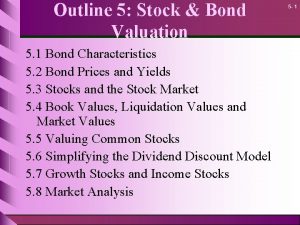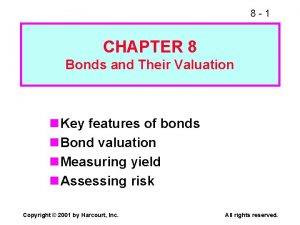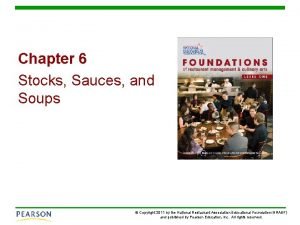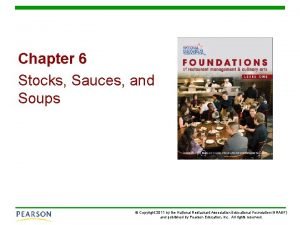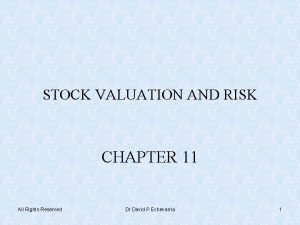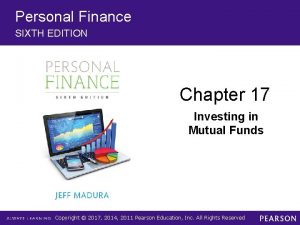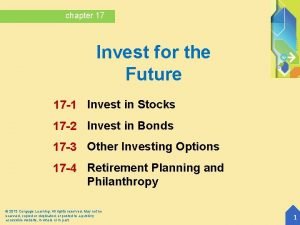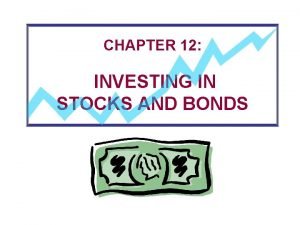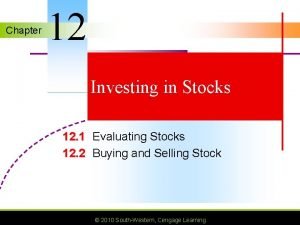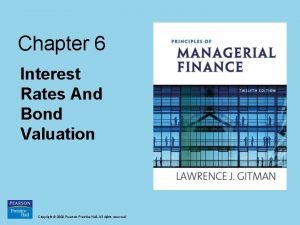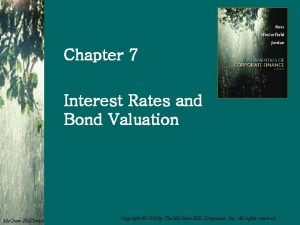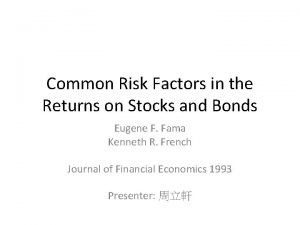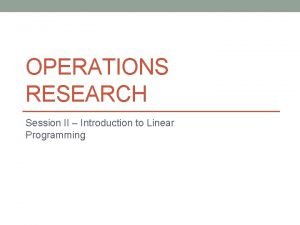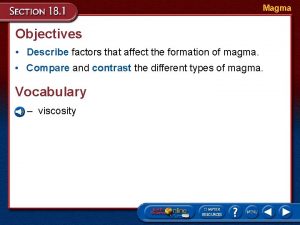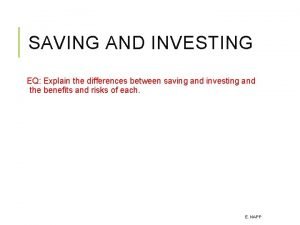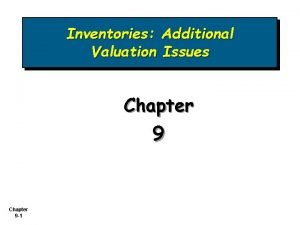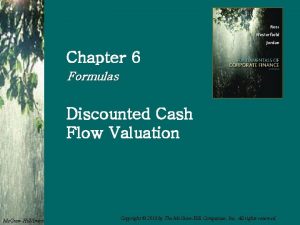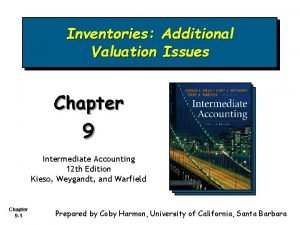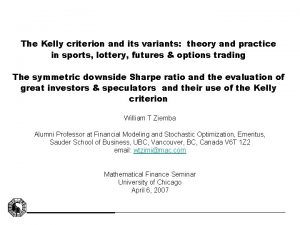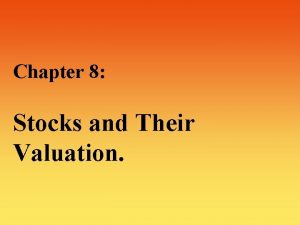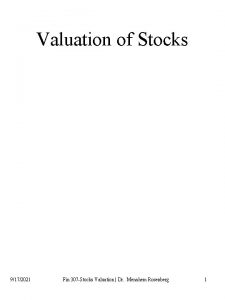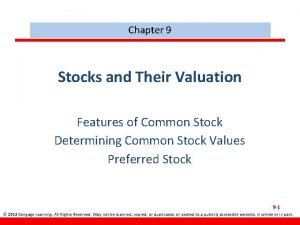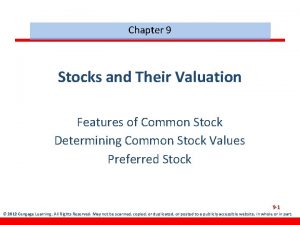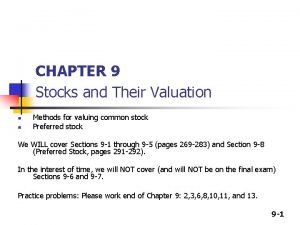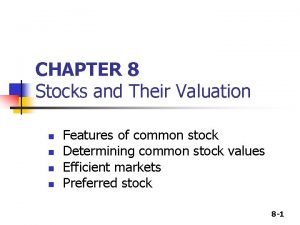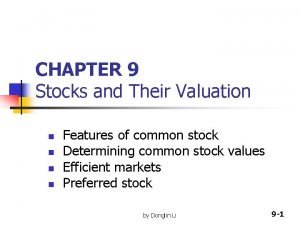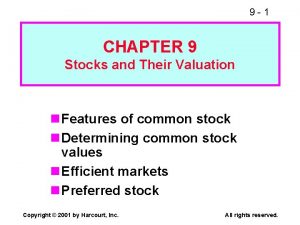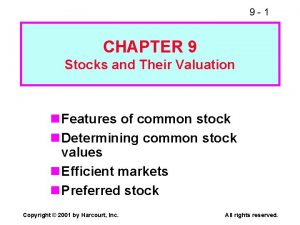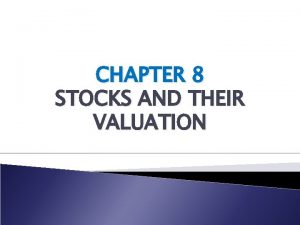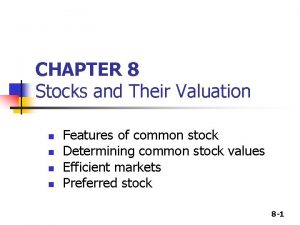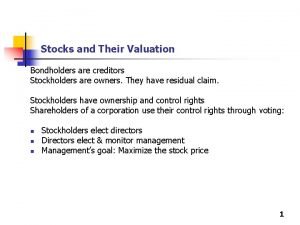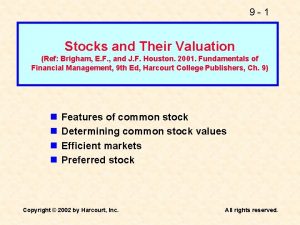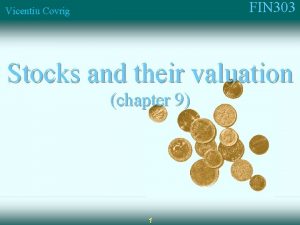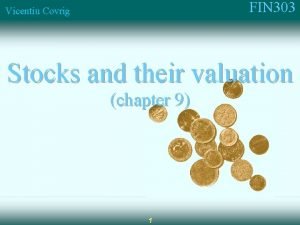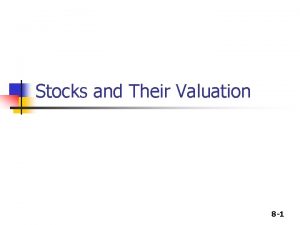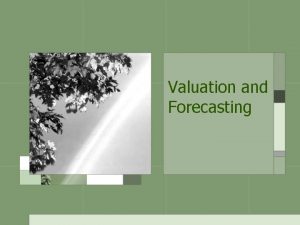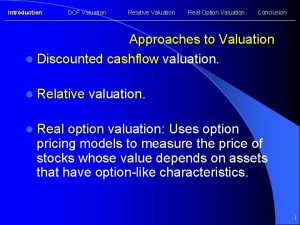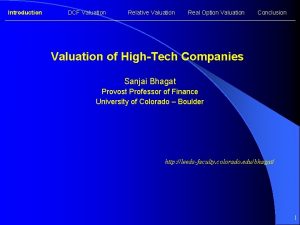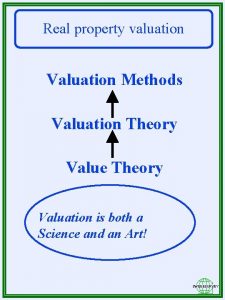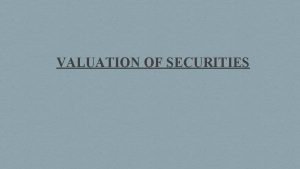CHAPTER 5 Stocks and Their Valuation n Features




































- Slides: 36

CHAPTER 5 Stocks and Their Valuation n Features of common stock Determining common stock values Preferred stock 9 -1

Common Stock n n n n Stockholders are owners of the firm. Stockholders are residual claimants. Stockholders have the right to: n vote at company meetings n dividends and other distributions n sell their shares Stockholders benefit in two ways: n dividends n capital gains Stock is issued by public corporations to finance investments. Stock is initially issued in the primary market (IPOs and secondary offerings). Stock is traded in the secondary market on organized exchanges. 9 -2

Steps in raising equity n Founder’s equity+ Friends & Family Angel Investors Venture capitalists Private financing n Public offering (IPO) n n n 9 -3

U. S. Stock Markets Major U. S. Stock Exchanges New York Stock Exchange (NYSE) National Association of Securities Dealers (NASDAQ) l l U. S. Stock Market l l Other Indices NYSE Composite Russell 2000 Wilshire 5000 Value Line 9 -4

World Stock Markets n n n New York Tokyo London Frankfurt Paris n n n Sydney Switzerland Hong Kong 9 -5

International Stock Market Indices 9 -6

Reading Stock Quotes 9 -7

Transactions Involving Stocks n n n Short Sell Buy s Sell stock without first s Savings motive owning it. s Expect stock to appreciate in value s Borrow stock from your broker with the promise to s Long position repay it at some later date. Sell s Sell the borrowed stock. s Liquidity needs s Repurchase it at a later date to repay your broker. s Expect stock to s Responsible for all dividends decline in value and other distributions while short the stock. 9 -8

Basic Valuation From “The Time Value of Money” we realize that the value of anything is based on the present value of the cash flows the asset is expected to produce in the future. 9 -9

Basic Valuation Asset value ^ ^ ^ CF = the cash flow expected to t be generated by the asset in period t n k = the return investors consider appropriate for holding such an asset--usually referred to as the required return-9 -10 based on riskiness and economic conditions.

Different approaches for estimating the intrinsic value of a common stock n n n Dividend growth model Corporate value model Using the multiples of comparable firms 9 -11

Dividend growth model n Value of a stock is the present value of the future dividends expected to be generated by the stock. 9 -12

Stock Valuation Models Terms: Expected Dividends 9 -13

Stock Valuation Models Terms: Market Price 9 -14

Stock Valuation Models Terms: Intrinsic Value 9 -15

Stock Valuation Models Terms: Growth Rate 9 -16

Stock Valuation Models Terms: Required Rate of Return 9 -17

Stock Valuation Models Terms: Dividend Yield 9 -18

Example: Dividend yield n If a firm is expected to pay a dividend of $2 (D 1 = $2). The current stock price is $40, what is the dividend yield? Dividend yield= D 1/ P 0 = 2 / 40 =5% 9 -19

Practice: Dividend yield n If a firm is expected to pay a dividend of $4 (D 1 = $4). The current stock price is $60, what is the dividend yield? Dividend yield= D 1/ P 0 = ? 9 -20

Constant growth stock n A stock whose dividends are expected to grow forever at a constant rate, g. D 1 = D 0 (1+g)1 D 2 = D 0 (1+g)2 Dt = D 0 (1+g)t n If g is constant, the dividend growth formula converges to: 9 -21

Example: Constant growth n If a firm just paid a dividend of $2 (D 0 = $2). The growth rate is expected to be constant at 10 %. If the cost of equity is 15%, what is the value of this stock? ^ P 0 = D 0(1+g) / (Ks – g) = 2(1. 10)/(0. 15 -0. 1) =44 9 -22

Practice: Constant growth n If a firm just paid a dividend of $5 (D 0 = $5). The growth rate is expected to be constant at 20 %. If the cost of equity is 25%, what is the value of this stock? ^ P 0 = ? ? ? 9 -23

Example: Constant growth n n n ABC Inc. is expected to pay a dividend of $5 (D 1 = $5) next year. The dividend is expected to grow at a constant rate of 6 %. If the cost of equity is 10%, what is the value of this stock? ^ P 0 = D 1 / (Ks – g) = 5 / (0. 10 -0. 06) =125 9 -24

Practice: Constant growth n n n ABC Inc. is expected to pay a dividend of $2 (D 1 = $2) next year. The dividend is expected to grow at a constant rate of 10 %. If the cost of equity is 14%, what is the value of this stock? ^ P 0 = ? 9 -25

Example: Non-constant growth A share just paid a dividend of $10. The dividend is expected to grow at 40 percent for the next three years. After that, dividend is expected to grow at a constant rate of 10 percent forever. The required rate of return is 20 percent. Calculate the value of this stock. 9 -26

Practice: Non-constant growth 9 -27

Corporate value model n n Also called the free cash flow method. Suggests the value of the entire firm equals the present value of the firm’s free cash flows. Find the market value (MV) of the firm, by finding the PV of the firm’s future FCFs. Subtract MV of firm’s debt to get MV of common stock. Divide MV of common stock by the number of shares outstanding to get intrinsic stock price (value). 9 -28

Applying the corporate value model 9 -29

Example: Corporate Value model 9 -30

Firm multiples method n Analysts often use the following multiples to value stocks. n n P/E P / CF P / Sales EXAMPLE: Based on comparable firms, estimate the appropriate P/E. Multiply this by expected earnings to back out an estimate of the stock price. 9 -31

Practice: Multiples method Lowell Inc. is going public soon. It is expected to earn $5 per share this year (EPS = $5). If a similar firm has a P/E ratio of 10, what should the value of Lowell Inc. ’s stock? P 0 = 5 * 10 = $50 9 -32

Practice: Multiples method Lowell Inc. is going public soon. It is expected to earn $6 cash per share this year (CF = $6). If a similar firm has a P/CF ratio of 15, what should the value of Lowell Inc. ’s stock? P 0 = ? 9 -33

Firm multiples method Lowell Inc. is going public soon. It is expected to have a sales of $10 million this year. It has 1 million shares outstanding. If a similar firm has a P/Sales ratio of 5, what should the value of Lowell Inc. ’s stock? P 0 = ? 9 -34

Changes in Stock Prices n n Investors change the rates of return required to invest in stocks. Expectations change about the cash flows associated with particular stocks. 9 -35

The Efficient Markets Hypothesis n n n The weak form of the EMH states that all information contained in the past price movements is fully reflected in current market prices. The semistrong form states that current market prices reflect all publicly available information. The strong form states that current market prices reflect all pertinent information, whether publicly available or privately held. 9 -36
 Valuation of stocks and bonds
Valuation of stocks and bonds Fixed income securities
Fixed income securities Bonds and their valuation
Bonds and their valuation Chapter 6 stocks sauces and soups
Chapter 6 stocks sauces and soups Chapter 6 stocks sauces and soups
Chapter 6 stocks sauces and soups Chapter 6 stocks sauces and soups
Chapter 6 stocks sauces and soups Bechamel sauce
Bechamel sauce Siteserve
Siteserve Dr david echevarria
Dr david echevarria Chapter 17 investing in stocks
Chapter 17 investing in stocks Chapter 17 investing in stocks
Chapter 17 investing in stocks Chapter 12 investing in stocks
Chapter 12 investing in stocks Chapter 12 investing in stocks
Chapter 12 investing in stocks Chapter 11 stocks
Chapter 11 stocks Store and reconstitute stocks sauces and soups
Store and reconstitute stocks sauces and soups Chapter 7 interest rates and bond valuation
Chapter 7 interest rates and bond valuation How to find the price of a bond
How to find the price of a bond Chapter 6 interest rates and bond valuation
Chapter 6 interest rates and bond valuation Chapter 7 interest rates and bond valuation
Chapter 7 interest rates and bond valuation Chapter 6 interest rates and bond valuation
Chapter 6 interest rates and bond valuation Classroom stock market game
Classroom stock market game Mother sauces names
Mother sauces names Five major sauces
Five major sauces Common risk factors in the returns on stocks and bonds
Common risk factors in the returns on stocks and bonds What are the four essential parts of stock
What are the four essential parts of stock A retail store stocks two types of shirts a and b
A retail store stocks two types of shirts a and b Brown beef stock appearance and presentation
Brown beef stock appearance and presentation How do batholiths, stocks, and laccoliths differ?
How do batholiths, stocks, and laccoliths differ? Preferred stock characteristics
Preferred stock characteristics Explain the investment poem concerning stocks and bonds.
Explain the investment poem concerning stocks and bonds. Stocks and sauces
Stocks and sauces Language features and their effects
Language features and their effects Language features and their effects
Language features and their effects Chapter 9 inventories additional valuation issues
Chapter 9 inventories additional valuation issues Chapter 6 discounted cash flow valuation
Chapter 6 discounted cash flow valuation Lower of cost or market
Lower of cost or market Fractional kelly criterion calculator
Fractional kelly criterion calculator
